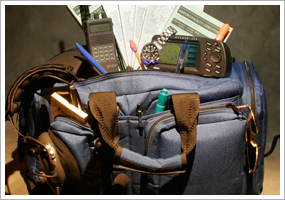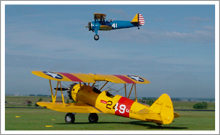| ||||
| | FT News | INSIDE AOPA | TRAINING PRODUCTS | FINAL EXAM | |||
TRAINING TIPsAviation wish lists
If your wish list still has unchecked items after the holidays, take those new gift certificates and address your needs yourself. From coping with cold to creating clearer communications (with your instructor and on the radio) a comfortable pilot trainee makes better progress than one who is cold, cramped, or confused. So make sure you have a warm pair of gloves for your winter preflights, and check out other products that can improve your comfort year-round.
You may have noticed, as one of the oldest sayings in aviation proclaims, that a crowded, noisy cockpit is not the ideal classroom. Using a headset to improve communications makes a night-and-day difference. “An aviation headset often is one of the first major purchases that a student pilot makes—and one of the most important. Headsets not only promote more effective communication, but they also provide invaluable hearing protection,” explains the AOPA Flight Training Headset Buyer’s Guide. Check out this resource page on AOPA Flight Training Online for other gadgets and gear that could ease your passage.
Not all the items on a student pilot’s wish list are tangibles. The holiday break is a good time to raise any questions you have about your progress. Do you feel the need for a second opinion about your skills, or a stage (phase) check? (Jill Tallman discusses this idea in the June 2004 AOPA Flight Training .) That’s a perfectly fair request, as Rod Machado explained to a doubting student in the May 2007 AOPA Flight Training “ Since You Asked” column.
Some trainees worry that they sometimes get butterflies. The presence of uneasiness in the stomach is experienced sometimes by all pilots. Not a bad thing, as Richard Hiner confides in the magazine’s June 2005 Instructor Report.
Take stock, and then move forward! Happy holidays from all your pilot friends at AOPA. YOUR PARTNER IN TRAININGNow that you’re learning about all the various rules and regulations that dictate how you must fly in the National Airspace System, no doubt you’ve thought about what might happen when you go afoul of one of those rules. A good legal insurance plan is the best medicine in these situations. AOPA’s Legal Services Plan offers all pilots, including students, access to an attorney in your area if the FAA comes knocking. It’s inexpensive, effective, and always there, just in case.
Did you know that student pilots who join AOPA are three times more likely to complete their flight training? Membership includes unlimited access to aviation information by phone (800/USA-AOPA, weekdays from 8:30 a.m. to 6 p.m. Eastern time) or from AOPA Flight Training Online or AOPA Online. If you’re not already a member, join today and get the pilot’s edge. Login information is available online. FLIGHT TRAINING NEWSCessna delivers first SkyCatcherCessna officially delivered its first production SkyCatcher last week, and it didn’t have to travel far. Rose Pelton, wife of CEO Jack Pelton, accepted the airplane at Yingling Aviation in Wichita, Kan. Pelton plans to use the airplane for flight training, setting off what promises to be the first of hundreds of aircraft used for the purpose. The SkyCatcher is Cessna’s first light sport aircraft, and the first from a major manufacturer in the United States. Cessna’s new two-seat trainer is built in China, disassembled, shipped, and then reassembled stateside. Yingling Aviation is a reassembly facility. Pilots join throng to witness Boeing 787 test flightFlight instructors and other pilots were among the nearly 2,000 people who turned out at Paine Field in Seattle on Dec. 15 to watch the first flight of the Boeing 787. “This happens just once in a decade,” said private pilot Tyler Nybord. “I would love to be in (the 787 test pilots’) shoes right now.” Four flight instructors traveled from Jacksonville, Fla., to attend the event. One of them, Denis Ndregjoni, said he has followed the progress of the 787 since doing a research paper on it in the seventh grade, according to a report on SeattlePI.com. FAA head downplays airline pilot hour requirement“We do not believe that simply raising quantity—the total number of hours of flying time or experience—without regard to the quality and nature of that time and experience—is an appropriate method by which to improve a pilot’s proficiency in commercial operations.” That was the message from FAA Administrator Randy Babbitt to a Senate committee recently in response to a House bill that would require future airline first officers to have 1,500 hours of total flight time. The bill passed the House on strong support from the families of victims of Colgan Flight 3407 that crashed near Buffalo, N.Y., earlier this year. Babbitt went on to say that the FAA believes more targeted experience, such as icing and high altitude operations, could substitute for total flight experience. LSA flight school opens in IllinoisProviding what it calls the first training academy of its kind in the region, SRT Aviation at Mount Vernon Airport in Mount Vernon, Ill., is now offering sport pilot training in a Jabiru J230. According to a report in the Mt. Vernon Register-News , SRT President Rich Carney said the school has four instructors and already a number of students. “This has been a long time coming,” Carney said. “We’ve seen the need and started actively pursuing it.” Winter rewardsWinter’s cold, dense air can improve your aircraft’s performance and provide for a glassy smooth flight. But the season also has hazardous weather in store, so take extra care to find out what potential dangers could await you on your next flight. Briefers, airmets, and pireps are all instrumental in making the decision whether or not to leave the ground. And if you decide to go, make sure your engine is properly warmed, your airframe is clear of ice, and you have checked the braking action report of your runway of intended use. Winter flying can be rewarding if you’re well prepared. To increase your knowledge about winter weather, check out articles and other online resources on the AOPA Air Safety Foundation’s updated Winter Weather Safety Spotlight. inside aopaChip the ice off your wing contamination knowledge bankIce, frost, and snow can accumulate on wings and other surfaces when an aircraft is parked outside on the ramp. The disrupted airflow can substantially alter flight characteristics. Do you know what to look out for on preflight? A basic knowledge of wing contamination and its effects will help you manage the risks of your next cold-weather flight. Test your knowledge with this AOPA Air Safety Foundation quiz, underwritten by the AOPA Insurance Agency. TRAINING PRODUCTSFlyboys IFR/VFR KneeboardA good kneeboard is a must-have item in flight training. The Flyboys IFR/VFR Kneeboard from Marv Golden features eyelets for securing checklists, charts, flight plans, and anything else you might need to have handy. There are pockets for items that need to be found quickly and pen slots so one is always handy. According to Marv Golden, these kneeboards have been used by the military extensively, so their quality is well established. It sells for $31.95.
Note: Products listed have not been evaluated by ePilot editors unless otherwise noted. AOPA assumes no responsibility for products or services listed or for claims or actions by manufacturers or vendors. FINAL EXAMQuestion: When looking at a sectional chart, why do some lakes have dashed blue borders and others have solid blue borders?
Answer: A shoreline marked by a dashed blue line indicates a fluctuating shoreline. Seasonal variations may cause lake or pond levels to rise and fall. When planning a flight over or near such a line, pilots should be aware that the actual shoreline and overall shape of the lake or pond may vary significantly from what is depicted on the sectional chart. To see more VFR sectional chart symbols, check out an extensive legend on AOPA Online.
Got a question for our technical services staff? E-mail [email protected] or call the Pilot Information Center, 800/872-2672. Don’t forget the online archive of “Final Exam” questions and answers, searchable by keyword or topic. Picture Perfect
AVIATION EVENTS & WEATHER To submit an event or to search all events in the calendar, visit AOPA Online. For airport details, including FBO fuel prices, see AOPA’s Airport Directory Online. Flight Instructor Refresher ClinicsThe next AOPA Air Safety Foundation Flight Instructor Refresher Clinics are scheduled in San Jose, Calif., Baltimore, Md., and Detroit, Mich., Jan. 9 and 10; Costa Mesa, Calif., Jackson, Miss., and Charlotte, N.C., Jan. 16 and 17; San Antonio, Texas, and Seattle, Wash., Jan. 23 and 24; Rochester, N.Y., Portland, Ore., and Sevierville, Tenn., Jan. 30 and 31. For a complete schedule, see AOPA Online.
Can’t make it in person? Sign up for the CFI Refresher Online. AOPA Air Safety Foundation Safety SeminarsAOPA Air Safety Foundation Safety Seminars are scheduled in Mesa, Ariz., and Reno, Nev., Jan. 11; Tucson, Ariz., and Sacramento, Calif., Jan. 12; Milpitas, Calif., Jan. 13; Santa Rosa, Calif., Jan. 14; San Diego, Calif., Jan. 25; Costa Mesa, Calif., Jan. 26; Ontario, Calif., Jan. 27; Burbank, Calif., Jan. 28; Little Rock, Ark., Feb. 1. Topics vary—for details and a complete schedule, see AOPA Online. | Got news? Contact ePilot. Having difficulty using this service? Visit the ePilot Frequently Asked Questions now at AOPA Online or write to [email protected]. |
| Member Tools : Send feedback | Update member profile | Change email address | Unsubscribe | ePilot Archive Editorial Team : ePilot Flight Training Editor : Ian Twombly | ePilot Editor: Sarah Brown | Contributor: Alton Marsh |

 When you made the decision to take on the challenge of learning to fly, personal comfort and serenity weren’t the first notions that came to mind. But cockpit comfort and a relaxed state of mind accelerate learning. And because you spend considerable time outside during winter months performing preflight inspections, comfort counts there too, helping get preflight chores done effectively and thwarting temptation to skip details.
When you made the decision to take on the challenge of learning to fly, personal comfort and serenity weren’t the first notions that came to mind. But cockpit comfort and a relaxed state of mind accelerate learning. And because you spend considerable time outside during winter months performing preflight inspections, comfort counts there too, helping get preflight chores done effectively and thwarting temptation to skip details.


